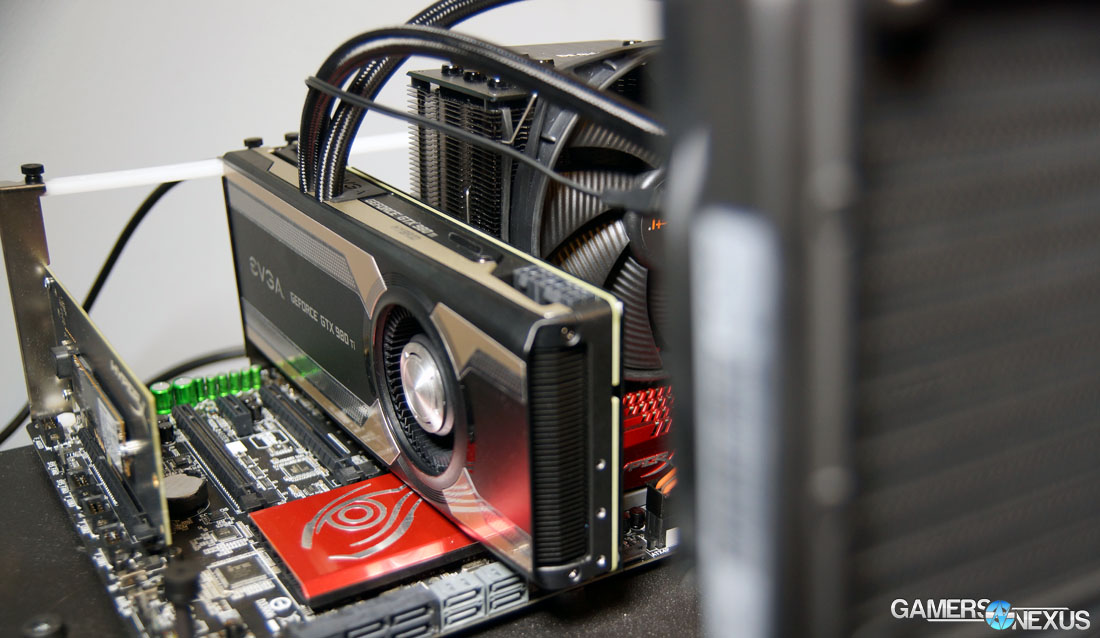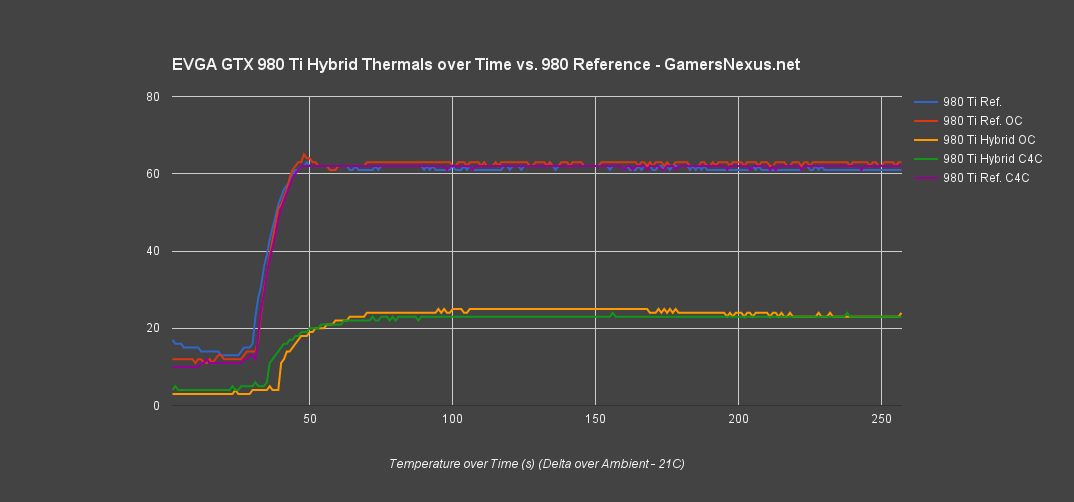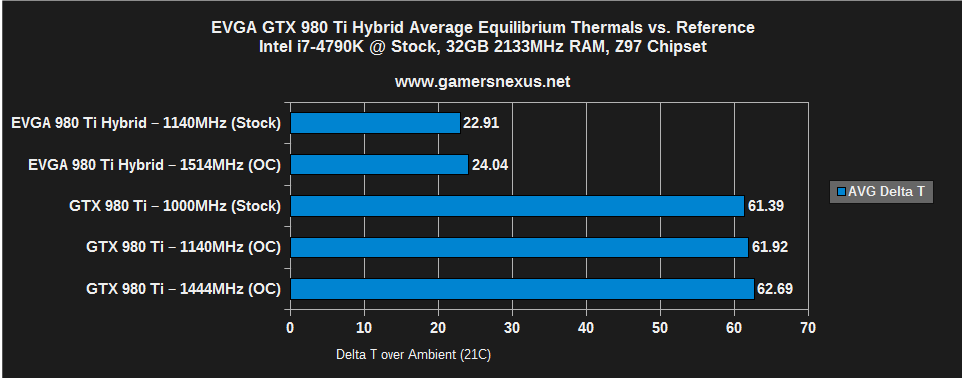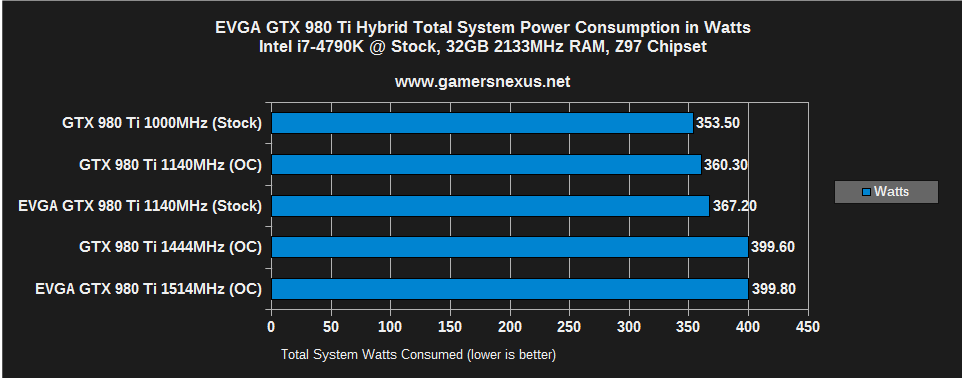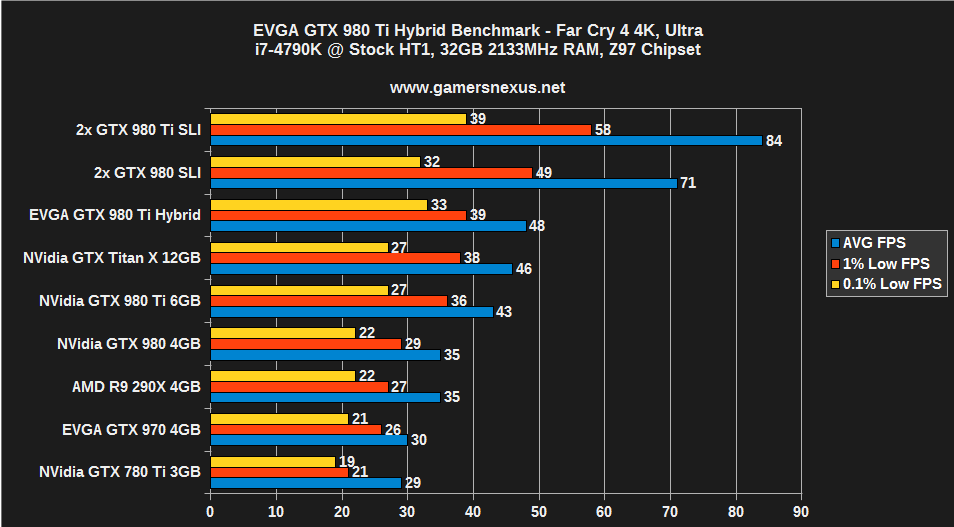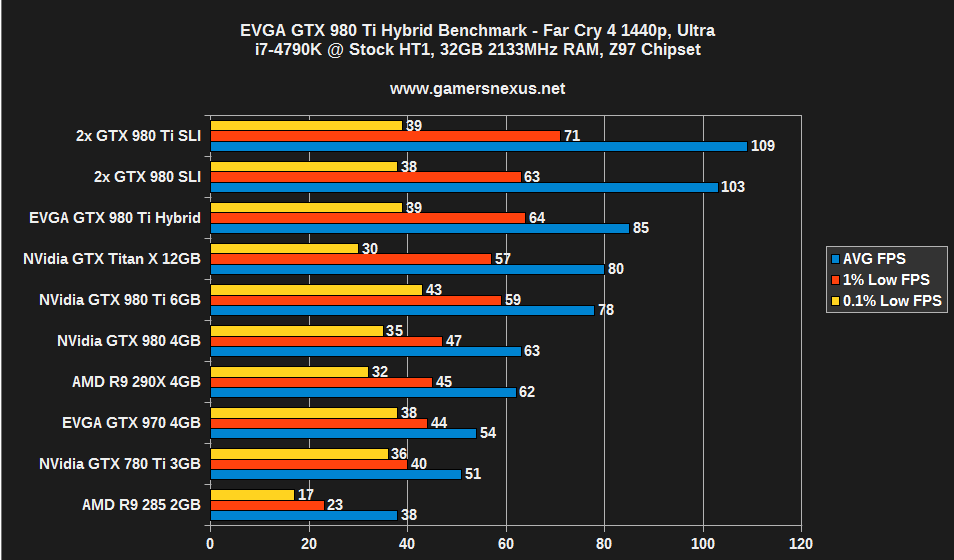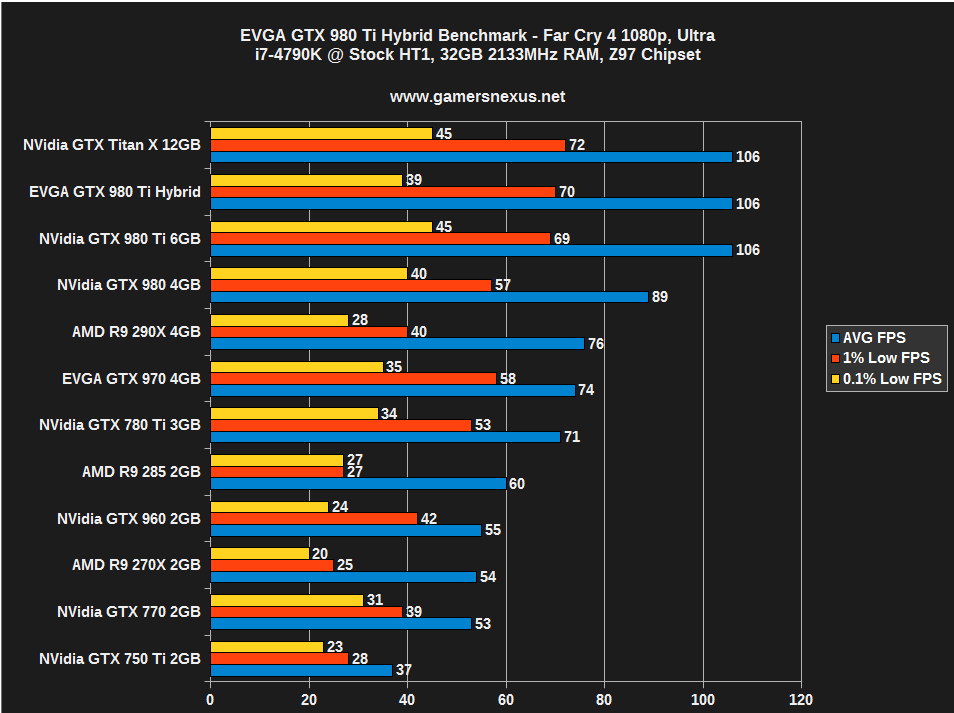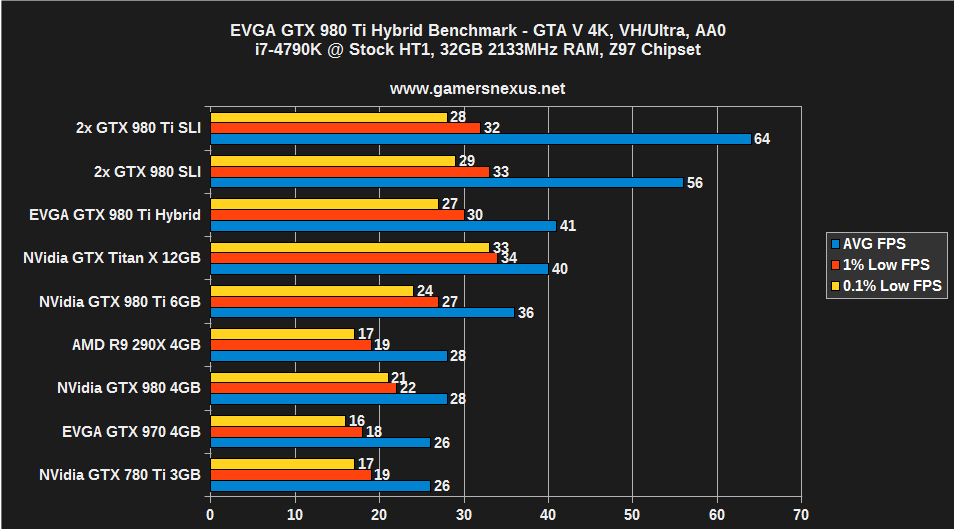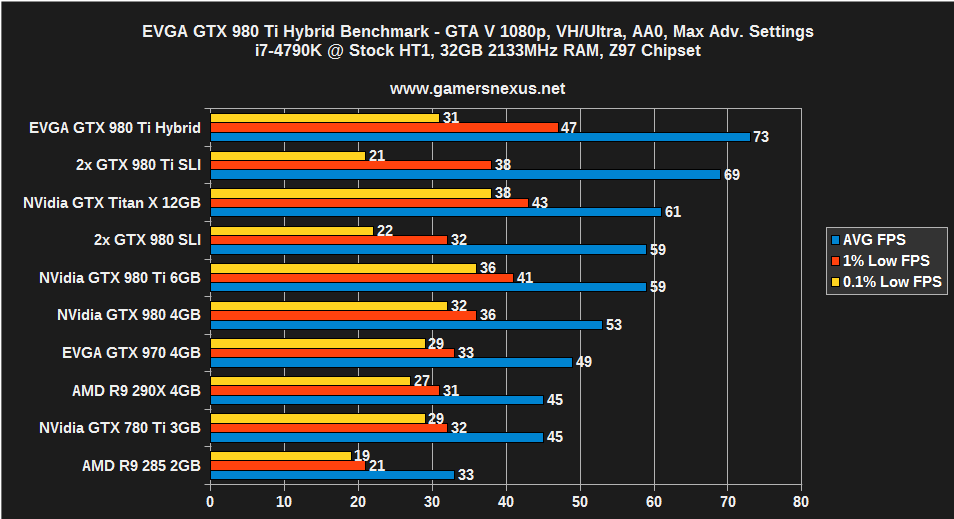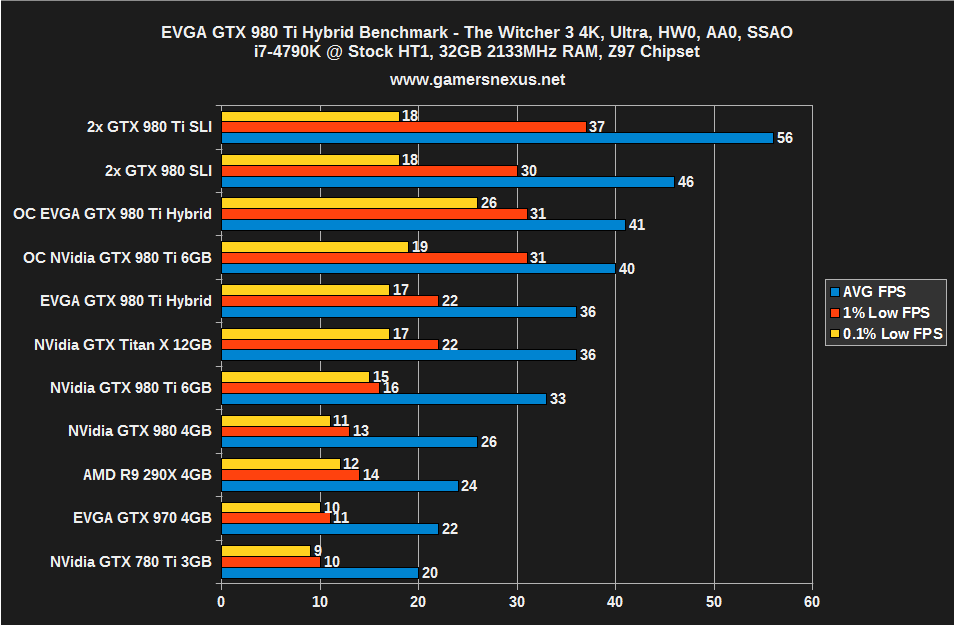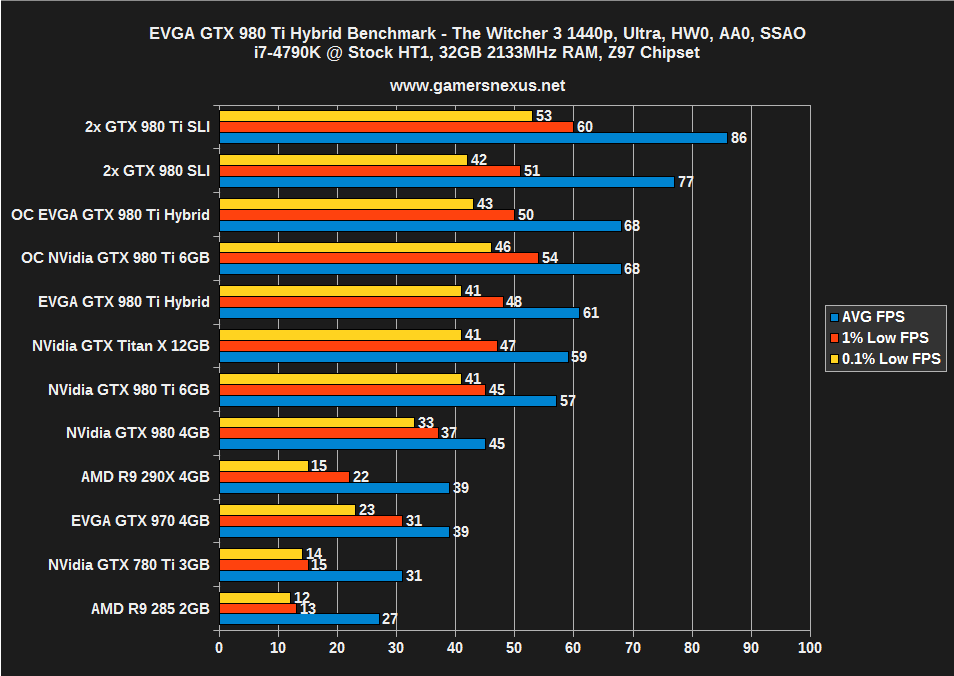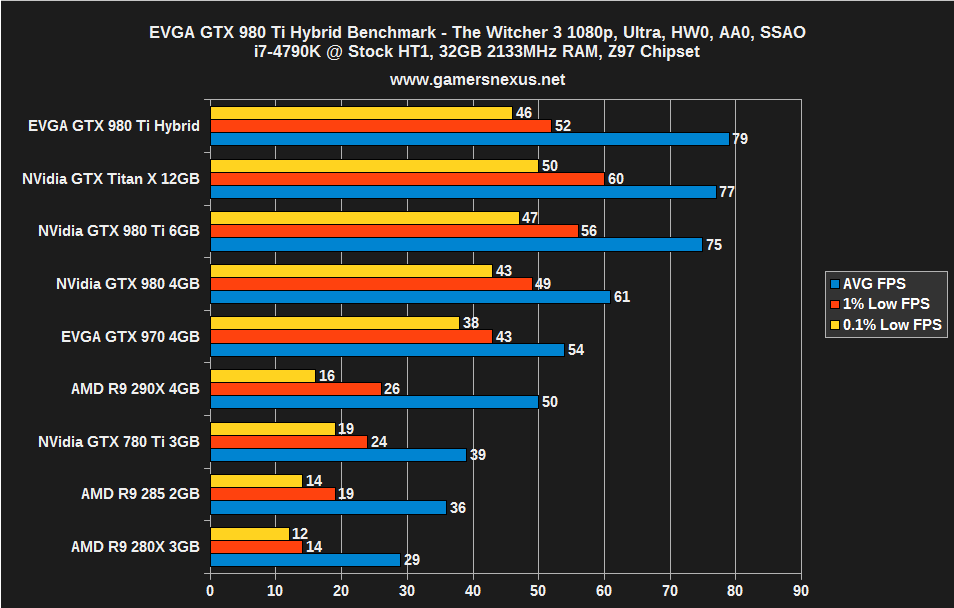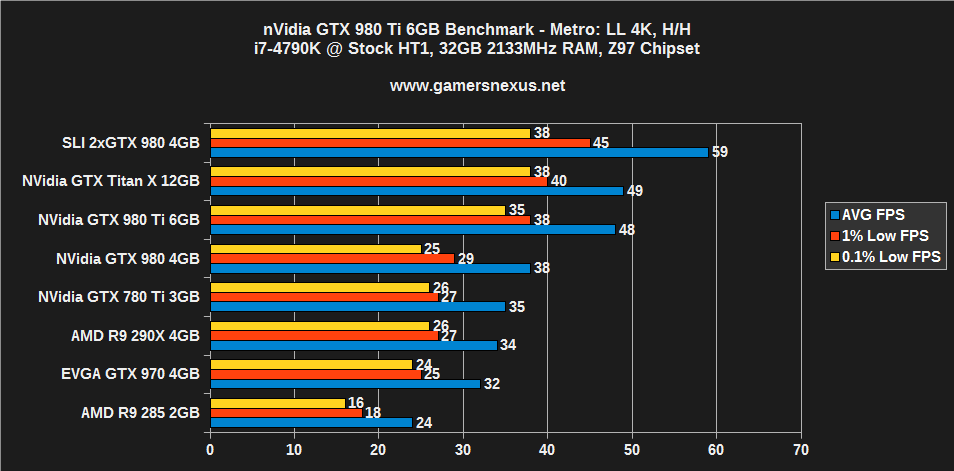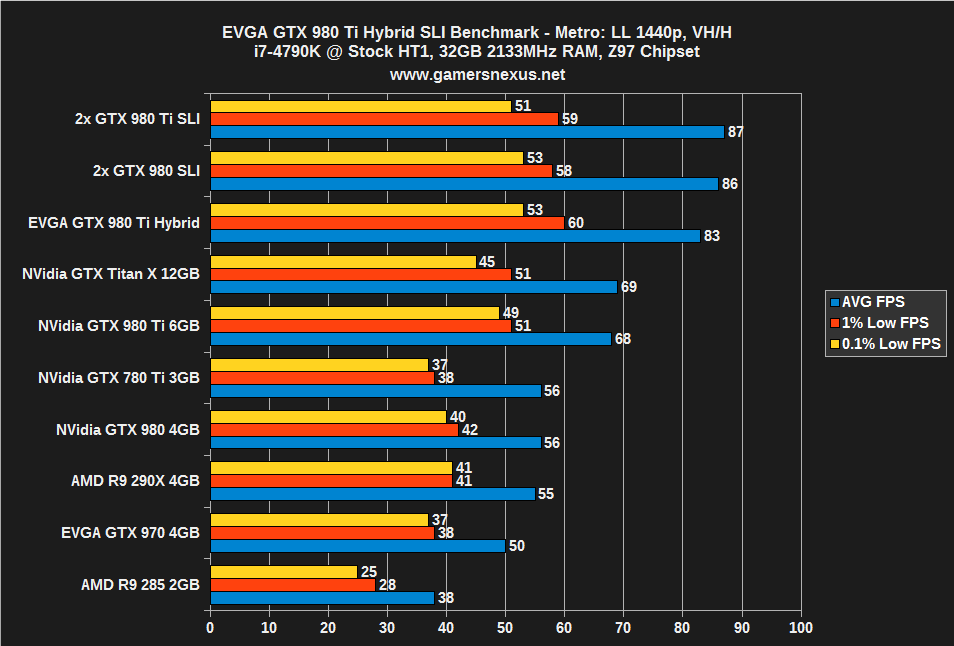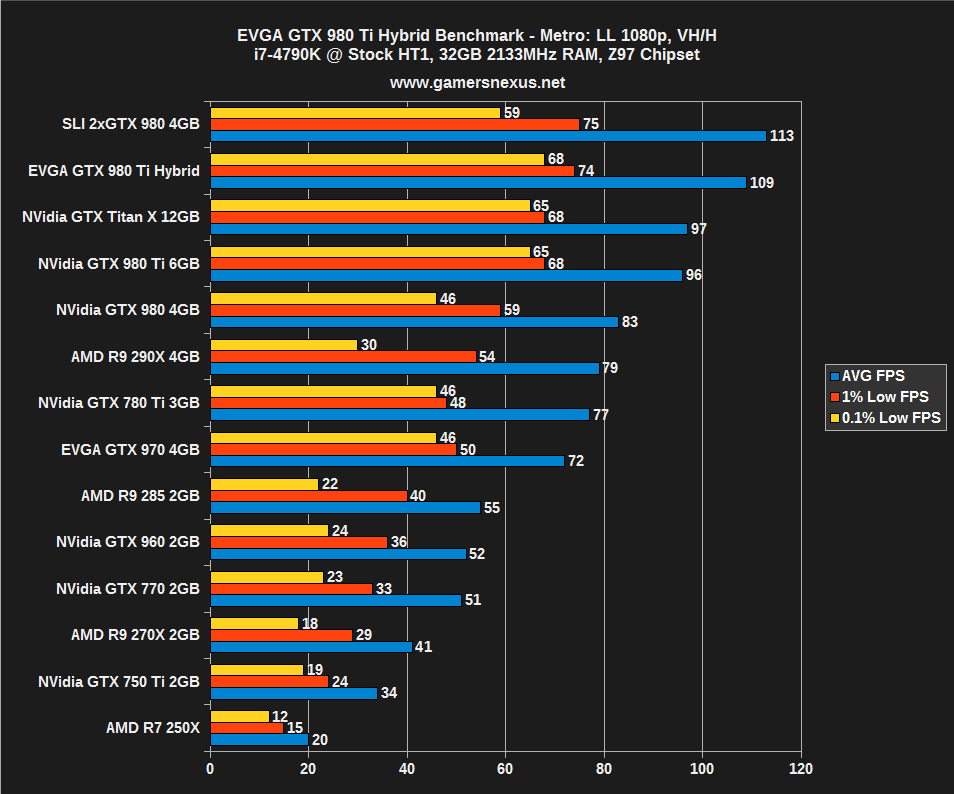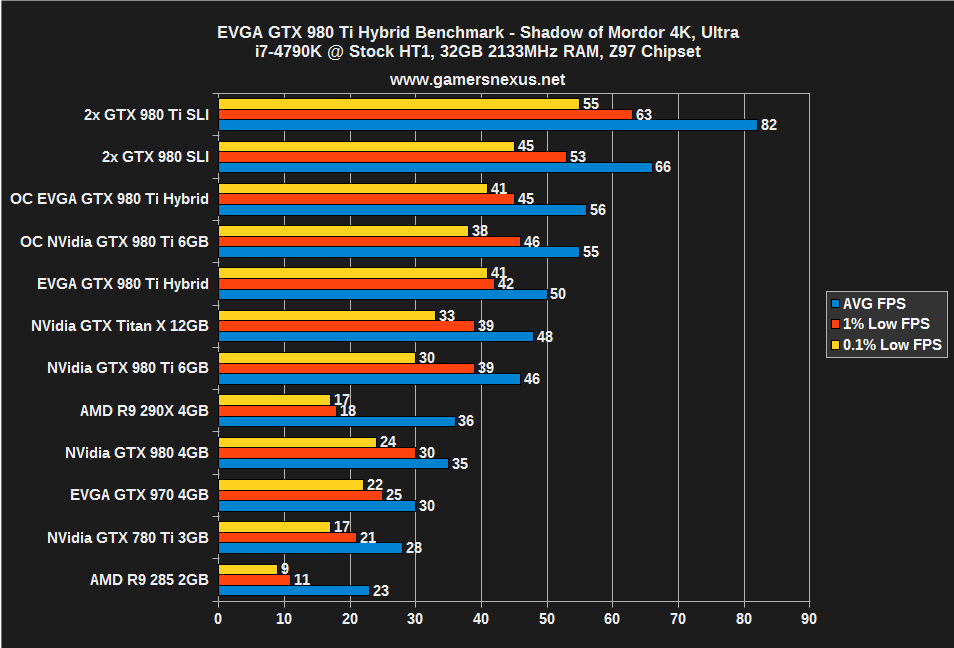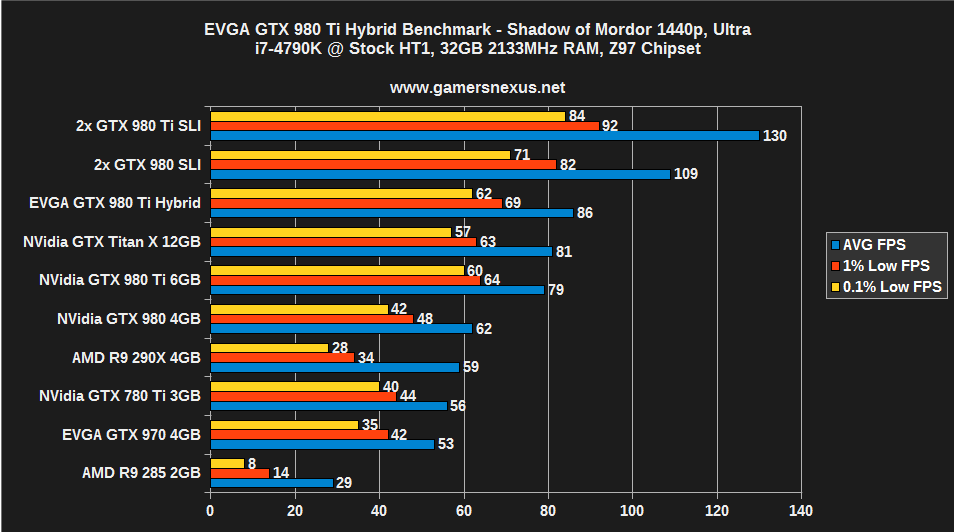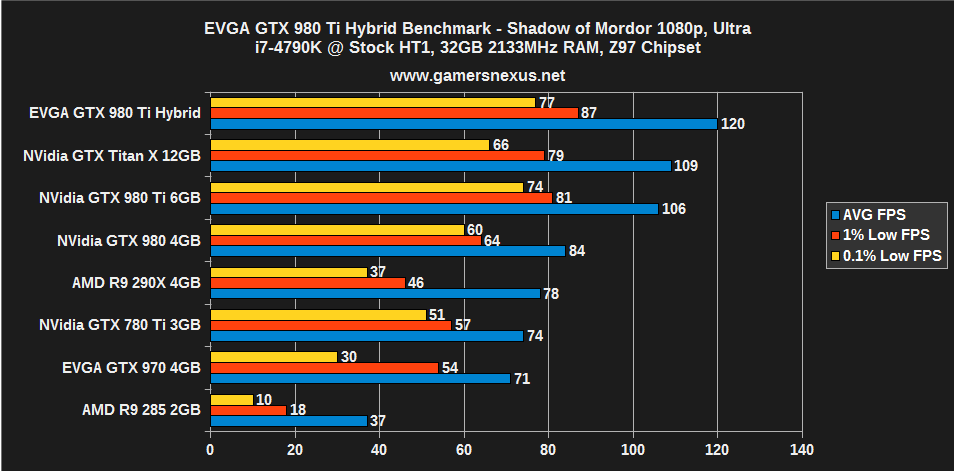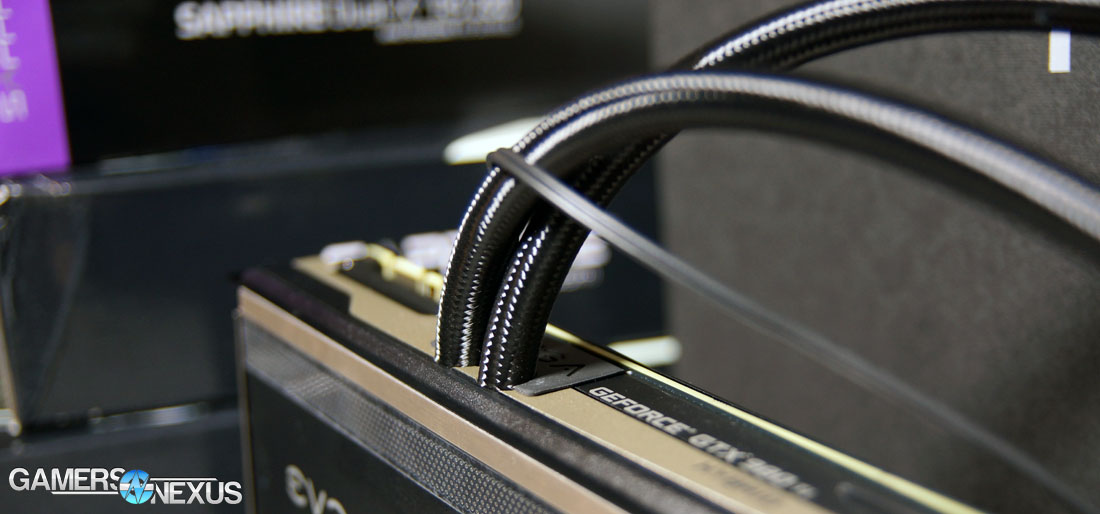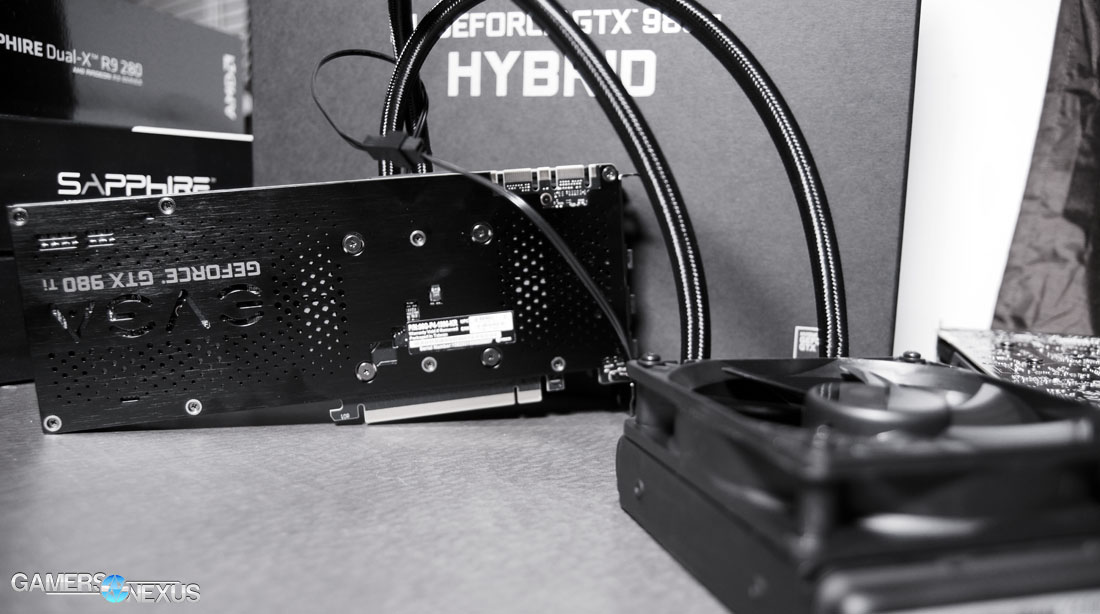EVGA GTX 980 Ti Hybrid Review - Liquid Cooled Overclocking and Thermal Benchmarks
Posted on
Working with the GTX 980 Ti ($650) proved that nVidia could supplant its own device for lower cost, limiting the use cases of the Titan X primarily to those with excessive memory requirements.
In our GTX 980 Ti overclocking endeavors, it was quickly discovered that the card encountered thermal bounds at higher clockrates. Driver failures and device instability were exhibited at frequencies exceeding ~1444MHz, and although a 40% boost in clockrate is admirable, it's not what we wanted. The outcome of our modest overclocking effort was an approximate ~19% performance gain (measured in FPS) for a selection of our benchmark titles, enough to propel the 980 Ti beyond the Titan X in gaming performance. Most games cared more about raw clock speed of the lower CUDA-count 980 Ti than the memory capacity of the TiX.
Further analysis of the data presented that, although the reference cooler keeps the device within safe operating temperatures, it starts to struggle under the thermal load produced by overvolting and overclocking. That's when we reached-out to EVGA to seek sampling of the company's GTX 980 Ti Hybrid ($770), a liquid-cooled version of the GTX 980 Ti. The Hybrid's deployment of traditional air cooling over the VRM and liquid on the GPU should afford higher overclocks within the thermal bounds of the GPU.
This review of EVGA's GTX 980 Ti Hybrid aims to determine the highest overclock possible of the 980 Ti, tests the temperatures and power consumption of the card, and looks at gaming performance.
Previous GTX 980 Ti Content
- GTX 980 Ti SLI Benchmark (2-Way)
- GTX 980 Ti Overclocking Performance a 19% FPS Gain
- NVidia GeForce GTX 980 Ti Review & Benchmark
EVGA GTX 980 Ti Hybrid Specs vs. Reference
| EVGA GTX 980 Ti Hybrid | GTX 980 Ti | GTX Titan X | GTX 780 Ti | |
| GPU | GM200 | GM200 | GM200 | GK-110 |
| Fab Process | 28nm | 28nm | 28nm | 28nm |
| Texture Filter Rate (Bilinear) | 176GT/s | 176GT/s | 192GT/s | 210GT/s |
| TjMax | 92C | 92C | 91C | 95C |
| Transistor Count | 8B | 8B | 8B | 7.1B |
| ROPs | 96 | 96 | 96 | 48 |
| TMUs | 176 | 176 | 192 | 240 |
| CUDA Cores | 2816 | 2816 | 3072 | 2880 |
| Base Clock (GPU) | 1140MHz | 1000MHz | 1000MHz | 875MHz |
| Boost Clock (GPU) | 1228MHz | 1075MHz | 1075MHz | 928MHz |
| GDDR5 Memory / Memory Interface | 6GB / 384-bit | 6GB / 384-bit | 12GB / 384-bit | 3GB / 384-bit |
| Memory Bandwidth (GPU) | 336.5GB/s | 336.5GB/s | 336.5GB/s | 336GB/s |
| Mem Speed | 7Gbps | 7Gbps | 7Gbps | 7Gbps |
| Power | 1-x8-pin 1x6-pin | 1x8-pin 1x6-pin | 1x8-pin 1x6-pin | 1x6-pin 1x8-pin |
| TDP | 250W | 250W | 250W | 250W |
| Output | 3xDisplayPort 1xHDMI 2.0 1xDL DVI | 3xDisplayPort 1xHDMI 2.0 1xDL DVI | 3xDisplayPort 1xHDMI 2.0 1xDual-Link DVI | 1xDVI-D 1xDVI-I 1xDisplayPort 1xHDMI |
| MSRP | $770 | $650 | $1000 | $600 |
First, note that the 980 Ti Hybrid modding kit is available for $100. For users who already own a 980 Ti, the kit can be purchased for boosted performance at a lower cost than the Hybrid standalone.
The 980 Ti Hybrid immediately offers a higher core clock than the reference spec. EVGA's version ships at 1140MHz core, 1228MHz boost, putting it firmly above the 1000MHz / 1075MHz (core/boost) of nVidia's reference design. That's a good thing, but not worth the extra ~$120 price premium on its own.
The most noteworthy change to the 980 Ti is EVGA's improved cooling design. The “Hybrid” portion of EVGA's branding refers to the cooler's fusion of air and liquid cooling for distributed dissipation of heat. A more traditional aluminum heatsink with grilled intake rests toward the front of the card (near the VRM) with a blower fan; the GPU proper hosts the CLC's pump, with braided tubing leading to the 120mm radiator and included fan. A copper coldplate directly contacts the GPU, though we recently highlighted the minimum impact of copper over aluminum for CLC coldplates.
EVGA's CLC is supplied by Asetek and was previously showcased in our CES coverage. Dismantling a Hybrid card, as we did with the 980, showcases a simple design that's primarily liquid cooled.
EVGA's marketing materials suggest an approximate ~52C GPU diode temperature on the 980 ti Hybrid, a marked improvement over the company's ~84C temperature measurement of the reference design. We tested this ourselves with more depth below, but if the gain remotely resembles the materials, overclocking immediately becomes less heat-intensive.
The Basics of Maxwell Overclocking
Overclocking on Maxwell, as we've written in OC guides before, is a little bit different from Kepler and other previous generation GPUs. The basics remain the same as all overclocking: Clockrates are incremented gradually to push GPU core performance, memory clocks can be increased to accelerate memory transactional datarates, and voltage is utilized to stabilize the GPU as the oscillation of the silicon crystals grows more rapid and volatile.
Feeding more voltage to a GPU will stabilize it, but there's only so much room for voltage increases. The GPU has a hard limiter at some manufacturer-defined spec (with nVidia oversight) to reduce the chance of the GPU getting killed from overvolting. In the case of EVGA's GTX 980 Ti Hybrid, the limit seems to be approximately 1.224v; reference voltage hovers around 1.187v pre-OC in our testing.
Voltage increases should be executed lightly, though. They increase heat and can damage the longevity of a GPU with great significance. Silicon likes heat, but only so much, and pushing closer to the TjMax (~91-95C) of the diode will reduce its usable lifespan.
Things change a little bit with Maxwell. We're presented with something called “Power Target (%)” in overclocking utilities, a new option that isn't present for other GPU architectures currently on-market. The power target rests at 100% when untouched, meaning that the GPU will draw 100% of the power it is specified to consume. TDP – defined as the amount of power required to adequately cool and operate the GPU – sits at ~250W for the 980 Ti. Increasing the percentage effectively opens the gates for more power consumption.
Power can be thought of as a limited resource that gets assigned to different functions of the GPU, primarily to the two clocks (core, memory), and is what will throttle overclocking potential when all other factors are stable. The GTX 980 Ti Hybrid can scale to 110% power – adding an additional 10% to base for overclocking. Some other cards, like MSI's GTX 980 (non-Ti), can scale to ~125%. We have not personally seen anything that exceeds ~126% power target.
Maxwell still overclocks the boost clock of the GPU, the GPU vCore, and the memory clock. Power target is used to increase the clockrates. Interestingly, overvolting consumes part of that power target, so there's a balance to be had between overvolting and overclocking to allow the maximum potential clockrate. Voltage and clocks draw from the same power pool.
Continue to Page 2 for the benchmarks and thermals.
Test Methodology
We tested using our updated 2015 GPU test bench, detailed in the table below. Our thanks to supporting hardware vendors for supplying some of the test components. Thanks to Jon Peddie Research for GTX 970 & R9 280X support.
The latest GeForce 353.06 drivers were used during testing. AMD Catalyst 15.5 was used. Game settings were manually controlled for the DUT. Clock-for-clock tests were performed, overclocking reference to ~1140MHz against the Hybrid. Note that, due to the way boost clocks work, a perfectly identical clockrate is not always possible -- but we can get close.
VRAM utilization was measured using in-game tools and then validated with MSI's Afterburner and AIDA64, a custom version of the Riva Tuner software. Parity checking was performed with GPU-Z. FPS measurements were taken using FRAPS and then analyzed in a spreadsheet.
Each game was tested for 30 seconds in an identical scenario on the two cards, then repeated for parity.
| GN Test Bench 2015 | Name | Courtesy Of | Cost |
| Video Card | NVIDIA EVGA | $650 $770 | |
| CPU | Intel i7-4790K CPU | CyberPower | $340 |
| Memory | 32GB 2133MHz HyperX Savage RAM | Kingston Tech. | $300 |
| Motherboard | Gigabyte Z97X Gaming G1 | GamersNexus | $285 |
| Power Supply | NZXT 1200W HALE90 V2 | NZXT | $300 |
| SSD | HyperX Predator PCI-e SSD | Kingston Tech. | TBD |
| Case | Top Deck Tech Station | GamersNexus | $250 |
| CPU Cooler | Be Quiet! Dark Rock 3 | Be Quiet! | ~$60 |
Average FPS, 1% low, and 0.1% low times are measured. We do not measure maximum or minimum FPS results as we consider these numbers to be pure outliers. Instead, we take an average of the lowest 1% of results (1% low) to show real-world, noticeable dips; we then take an average of the lowest 0.1% of results for severe spikes.
We conducted a large suite of real-world tests, logging VRAM consumption in most of them for comparative analysis. The games and software tested include:
- Far Cry 4 (Ultra 1080, Very High 1080).
- GRID: Autosport (Ultra 1440, Ultra 4K).
- Metro: Last Light (Very High + Very High tessellation at 1080; High / High at 1440).
- GTA V (Very High / Ultra at 1080p).
- Shadow of Mordor (Very High, 1080p).
- 3DMark Firestrike Benchmark
- GTA V
- The Witcher 3
We already know GTA V and Far Cry 4 consume massive amounts of video memory, often in excess of the 2GB limits of some cards. GRID: Autosport and Metro: Last Light provide highly-optimized benchmarking titles to ensure stability on the bench. Shadow of Mordor, GTA V, & The Witcher 3 are new enough that they heavily eat VRAM. 3DMark offers a synthetic benchmark that is predictable in its results, something of great importance in benchmarking.
Overclocked tests were conducted using EVGA Precision for application of settings. All devices were tested for performance, stability, and thermals prior to overclocking to ensure clean results. On the OC bench, devices were set to maximize their voltage ceiling with incremental gains applied to the core clock (GPU) frequency. 3DMark Firestrike was used on infinite loop to determine stability in a relatively real-world scenario. Once stability was compromised -- either from crashing or artifacting -- we attempted to resolve the issue by fine-tuning other OC settings; if stability could not be achieved, we backed-down the core clock frequency until we were confident of stability. At this point, the device was placed on a burn-in test using 3DMark Firestrike for 25 minutes. If the settings survived this test without logged fault, we recorded the OC settings and logged them to our spreadsheet.
Final OCs were applied and tested on games for comparison.
Thermals were reported using Delta T over ambient throughout a 25-minute burn-in period using 3DMark FireStrike - Extreme on infinite loop, which renders graphics at 1440p resolution. This test loads the VRAM heavily, something Kombustor skips, and keeps the GPU under high load that is comparable to gaming demands. Temperatures were logged using AIDA64.
Overclocking Results
| CLK Offset | Max Clock | Mem Offset | Mem CLK | Voltage | Initial Test | Endurance? |
| +100MHz | 1453MHz | +500MHz | 4001MHz | 1.224V | Pass | N/A |
| +120MHz | 1474MHz | +500MHz | 4001MHz | 1.224V | Pass | N/A |
| +130MHz | 1483MHz | +500MHz | 4001MHz | 1.224V | Pass | N/A |
| +140MHz | 1494MHz | +500MHz | 4001MHz | 1.224V | Pass | N/A |
| +160MHz | 1514MHz | +500MHz | 4001MHz | 1.224V | Pass | N/A |
| +175MHz | 1529MHz | +500MHz | 4001MHz | 1.224V | Pass | Unstable |
| +180MHz | 1533MHz | +500MHz | 4001MHz | 1.224V | Pass | Fail |
| +170MHz | 1524MHz | +500MHz | 4001MHz | 1.224V | Pass | Fail |
| +160MHz | 1514MHz | +500MHz | 4001MHz | 1.224V | Pass | Pass |
For overclocking, we configure the power percent target to its maximum value before adjusting voltage to its own max setting. The 980 Ti allows 110% of base power to be supplied to the GPU for overclocking and seems to hover around 1.224V after overvolting. We then slowly increment clockrate, observing for visual artifacting or catastrophic failures throughout the process. Each increment is left only for a few minutes before moving to the next step. We're eventually confronted with a driver failure, at which point the clockrate is backed-down and then endurance tested for 25-minutes using 3DMark Firestrike Extreme on loop.
We were able to get the 980 Ti Hybrid to perform with stability at +160MHz offset, or 1514MHz. There was a brief period of stability at +170MHz (1524MHz boost), but volatility was found approximately twenty minutes into burn-in testing. We left the memory clock OC'd to +500MHz offset, though it could likely be pushed further with granular tweaking. Our main concern is the core and boost clocks.
To this end, a 1514MHz final clock is a significant improvement over the GTX 980 Ti reference model's ~1444MHz resting place. Here's the table for our GTX 980 Ti (reference) overclocking steps:
| CLK Offset | Max Clock | Mem Offset | Mem CLK | Voltage | Initial Test | Endurance? |
| +68MHz | 1245MHz | +500MHz | 4001MHz | 1.187V | Pass | N/A |
| +100MHz | 1289MHz | +500MHz | 4001MHz | 1.187V | Pass | N/A |
| +150MHz | 1339MHz | +500MHz | 4001MHz | 1.187V | Pass | N/A |
| +175MHz | 1364MHz | +500MHz | 4001MHz | 1.187V | Pass | N/A |
| +200MHz | 1389MHz | +500MHz | 4001MHz | 1.187V | Pass | N/A |
| +225MHz | 1414MHz | +500MHz | 4001MHz | 1.187V | Pass | N/A |
| +250MHz | 1439MHz | +500MHz | 4001MHz | 1.187V | Pass | N/A |
| +275MHz | 1464MHz | +500MHz | 4001MHz | 1.212V | Fail | Fail |
| +250MHz | 1427MHz | +500MHz | 4001MHz | 1.212V | Pass | Pass |
| +255MHz | 1444MHz | +500MHz | 4001MHz | 1.212V | Pass | Pass |
| +260MHz | 1450MHz | +500MHz | 4001MHz | 1.212V | Pass | Fail |
Note that the offsets are higher for the reference model because it has a lower starting place. We performed clock-for-clock thermal testing between the two cards, found in the next section.
GTX 980 Ti Hybrid Thermals vs. Reference
We've got two charts above and one below, in this order: Line graph of thermals over time, bar graph of average temperatures once equilibrium is reached, and below, a bar graph of measured power consumption in wattage of the GTX 980 Ti and GTX 980 Ti Hybrid. The test period for the temporal chart was 25 minutes.
EVGA's GTX 980 Ti Hybrid keeps itself cooler for longer once the GPU falls under heavy load and, as made obvious above, has a substantially lowered maximum temperature. Thermals of the EVGA 980 Ti Hybrid are hands-down impressive at a temperature reduction of more than 2X. The Hybrid's 100% loaded thermal range is 22.91C to 24.04C (overclocked), with the clock-for-clock 980 Ti reference at 61.92C and stock at 61.39C. That's a massive difference. After adding ambient back in, our GPUs were sitting in the 40s with the Hybrid and in the 80s with the reference cooler design, which is approaching TjMax of the diode.
The thermal reduction alone is “worth” the added price, but can be hard to swallow for some buyers. Reducing thermals of the GPU will reduce temperatures of the neighboring CPU, RAM, and chipset, driving down temperatures of the system in its entirety. Lower temperatures mean lower fan operating speeds – the CPU can throttle-down, as can the case fans – and thus lower acoustics.
After looking at FPS performance in games, we'll have a better understanding of ROI on the Hybrid. First, watts consumed:
Power is effectively identical between the two cards, so Asetek's solution doesn't draw a noteworthy gain over reference.
GTX 980 Ti Hybrid Benchmark – Far Cry 4
Far Cry 4 sees slightly boosted performance over the Titan X, something the reference GTX 980 Ti was uncapable of achieving given the marginally lower core count. This is noteworthy and assists in the price increment of EVGA's card. Although it's not shown in these charts, overclocking the reference GTX 980 Ti would also outperform the Titan X -- something we tested here.
GTX 980 Ti Hybrid Benchmark – GTA V
Clockrate increases are reflected most heavily in GTA V when the "Advanced Settings" are maximized, with the difference producing effectively insignificant results with these settings disabled or lowered. The Hybrid offers a great performance boost in this instance and remains tied with the reference 980 Ti in the 4K, non-advanced-settings test.
GTX 980 Ti Hybrid Overclock Benchmark – The Witcher 3
GTX 980 Ti Hybrid Overclocking Benchmark – Metro: Last Light
GTX 980 Ti Hybrid Overclocking Benchmark – Shadow of Mordor
Conclusion
Performance gains are a bit more volatile and unpredictable with the GTX 980 Ti Hybrid when compared against the Titan X and SLI 980 Tis. The SLI testing reflects inconsistencies in software optimization for multi-GPU configurations and also utilizes two GPUs, so isn't exactly the same market as a single Hybrid would be.
Looking at the 980 Ti Hybrid and the Titan X, we see the two trade blows in a few places, but are generally sitting near one another. Some games, like GTA V at 1080p with maximized advanced settings, reflect a massive performance gain strictly from the boosted core clock. When GTA V uses no advanced settings (but 4K with maximum core graphics options), we see a much smaller ~1FPS margin of error gain over the Titan X. Because the architecture is identical and the only real differences come in the clockrate and RAM – which won't get saturated at 6GB, anyway – the biggest performance gains are reflected by the clock increase.
Far Cry 4 shows tied 1080p performance at the top-end due to a likely CPU bottleneck, but 4k performance shows a 2FPS gain in the 980 Ti Hybrid over the TiX and a ~5FPS gain over the reference design. When we look to overclocking, the 980 Ti Hybrid has large gains over its stock clock at 68FPS (1440p) against 61FPS (1440p stock), but is matched nearly equally with the 980 Ti at all levels of the clock. Overclocking the Hybrid card doesn't immediately produce unbeatable framerates by the reference design or stock Titan X, but there's more to the story than that: With a substantially lower thermal footprint, the Hybrid version of the card – although it performs similarly to the 980 Ti reference at overclocked levels – is >2X cooler and will offer a longer lifespan resultant of the reduction in thermals. The card will also hold equivalent overclocks with less effort, so modest OCs can be applied with marginally lower voltage.
The 980 Ti Hybrid does have an added cost, but it generally performs better than or equal to the Titan X at its stock clocks. The value-add from liquid cooling is significant and should be acknowledged by anyone seeking to overclock the card or reduce overall system thermals. An SFF box, for instance, would see great gains from the liquid cooled card if there's room for the radiator. At an added ~$120, the card may enter inaccessible pricing territory for some high-end users. If this is the case, the reference 980 Ti is still a solid performer and is cooled well enough, but shouldn't be overclocked as aggressively as the 980 Ti Hybrid.
Our Editor's Choice and Best of Bench awards go to EVGA for its high-performance, exceptionally cool execution of a liquid-cooled GTX 980 Ti.
- Steve “Lelldorianx” Burke.
